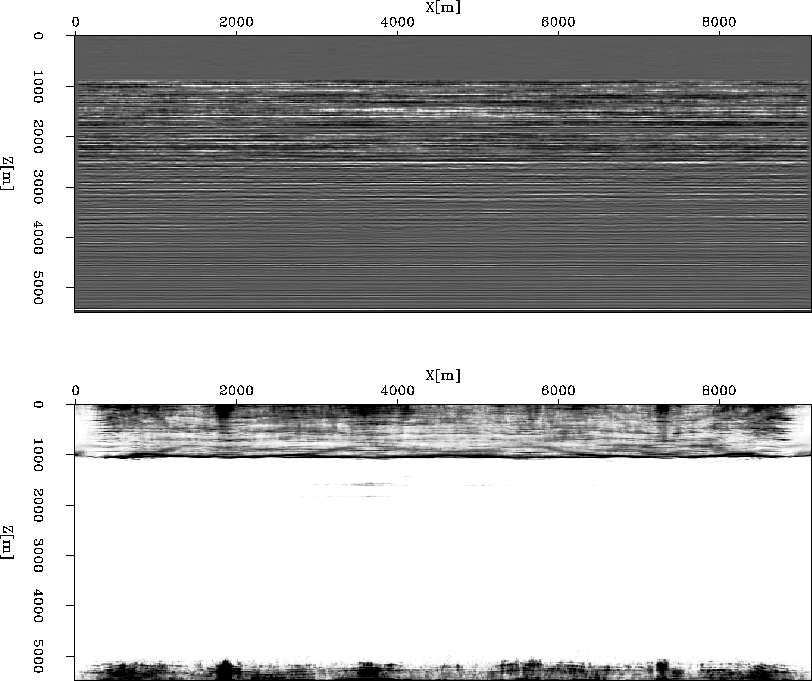




Next: In the presence of
Up: FEAVA in the image
Previous: FEAVA in the image
The top panel of Figure ![[*]](http://sepwww.stanford.edu/latex2html/cross_ref_motif.gif) displays the result
of migrating the multiple-free data with the background velocity shown
in the left panel of Figure
displays the result
of migrating the multiple-free data with the background velocity shown
in the left panel of Figure ![[*]](http://sepwww.stanford.edu/latex2html/cross_ref_motif.gif) . High-amplitude vertical
streaks mark the presence of FEAVA. The FEAVA detector
Vlad (2004) works by measuring the departure of AVA from
the Shuey (1985) model. The output of the detector (bottom panel
of Figure
. High-amplitude vertical
streaks mark the presence of FEAVA. The FEAVA detector
Vlad (2004) works by measuring the departure of AVA from
the Shuey (1985) model. The output of the detector (bottom panel
of Figure ![[*]](http://sepwww.stanford.edu/latex2html/cross_ref_motif.gif) ) highlights the AVA much more clearly than
the stack. Migrating with the adjoint of the modeling operator
(split-step, three reference velocities) eliminates the FEAVA from the
image (Figure
) highlights the AVA much more clearly than
the stack. Migrating with the adjoint of the modeling operator
(split-step, three reference velocities) eliminates the FEAVA from the
image (Figure ![[*]](http://sepwww.stanford.edu/latex2html/cross_ref_motif.gif) ).
com_nomult_imag
).
com_nomult_imag
Figure 3 FEAVA is present after
migrating the multiple-free data with the background velocity.
Top: as higher-amplitude streaks in the stack (barely visible);
Bottom: after applying the FEAVA detector.




 com_nomult_imaC
com_nomult_imaC
Figure 4 FEAVA disappears after
migrating the multiple-free data with the correct velocity and the
exact adjoint of the modeling operator. Top: Stack.
Bottom: after applying the FEAVA detector. Compare with lower
panel of Figure ![[*]](http://sepwww.stanford.edu/latex2html/cross_ref_motif.gif)










Next: In the presence of
Up: FEAVA in the image
Previous: FEAVA in the image
Stanford Exploration Project
10/23/2004

![[*]](http://sepwww.stanford.edu/latex2html/cross_ref_motif.gif) displays the result
of migrating the multiple-free data with the background velocity shown
in the left panel of Figure
displays the result
of migrating the multiple-free data with the background velocity shown
in the left panel of Figure ![[*]](http://sepwww.stanford.edu/latex2html/cross_ref_motif.gif) . High-amplitude vertical
streaks mark the presence of FEAVA. The FEAVA detector
Vlad (2004) works by measuring the departure of AVA from
the Shuey (1985) model. The output of the detector (bottom panel
of Figure
. High-amplitude vertical
streaks mark the presence of FEAVA. The FEAVA detector
Vlad (2004) works by measuring the departure of AVA from
the Shuey (1985) model. The output of the detector (bottom panel
of Figure ![[*]](http://sepwww.stanford.edu/latex2html/cross_ref_motif.gif) ) highlights the AVA much more clearly than
the stack. Migrating with the adjoint of the modeling operator
(split-step, three reference velocities) eliminates the FEAVA from the
image (Figure
) highlights the AVA much more clearly than
the stack. Migrating with the adjoint of the modeling operator
(split-step, three reference velocities) eliminates the FEAVA from the
image (Figure ![[*]](http://sepwww.stanford.edu/latex2html/cross_ref_motif.gif) ).
).


![[*]](http://sepwww.stanford.edu/latex2html/cross_ref_motif.gif)